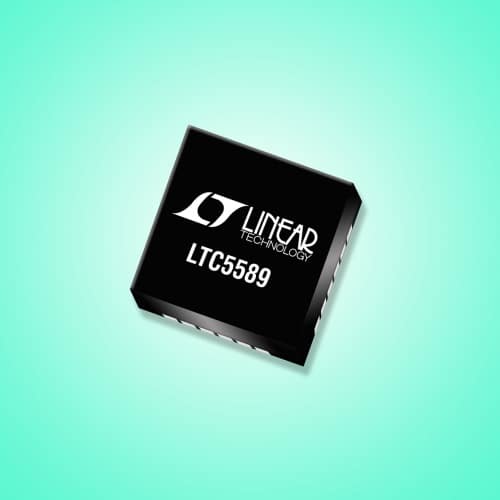
Linear Technology introduces a new low power I/Q modulator, the LTC5589, which enables battery-powered, high performance broadband transmitters operating in the range from 700MHz to 6GHz. Powered by a single 2.7V to 3.6V supply, the LTC5589 modulator draws only 29.5mA current, 50% lower power consumption than other solutions. The new modulator exhibits best-in-class sideband suppression performance of -50dBc and carrier leakage of -43dBm typical without calibration. Sideband and carrier suppression can be further improved by using the on-chip tuning capabilities via the SPI bus, to better than -60dBc and -60dBm, respectively. Moreover, the device has a very low output noise floor of -158.8dBm/Hz, combined with OIP3 of 19dBm, resulting in superior transmitter performance.
The LTC5589 supports narrowband as well as wideband transmitters. Its baseband bandwidth extends to 92MHz with ±1dB gain flatness, providing 184MHz RF bandwidth at 1.8GHz. Combined with low power consumption and robust performance, the device is suitable for a wide range of demanding applications for radios and wireless communications. These include broadband modems, femto- and picocell broadband wireless access, wireless microphones and portable audio systems, broadband portable field radios, unlicensed band radios, train communications, software-defined radios, portable RF test equipment, low-power microwave backhaul and repeaters, telemetry radios and satellite modems.
Prior zero-IF modulators exhibit excessive carrier leakage and poor sideband suppression, resulting in poor Error Vector Magnitude (EVM) and Adjacent Channel Power Ratio (ACPR). Calibration is challenging and relies on digital tuning algorithms in the baseband FPGA using external DACs. Tuning resolution is typically limited. The LTC5589 provides on-chip tuning capability of the I-channel and Q-channel phase and amplitude mismatch, which affect sideband suppression. The device also has DC offset balance adjustment, which affects carrier leakage. With built-in serial port controlled calibration capability, the LTC5589 simplifies calibration and is cost-effective to implement.
The LTC5589’s gain can be set via the on-chip serial port. A coarse gain control provides 1dB/step, along with adjustable fine gain control of 0.1dB. Total gain ranges from -19dB to 0dB. Varying the modulator gain affects device supply current from 9mA to 39mA, so the device can be set to lower power consumption with slightly reduced gain and performance, as needed for specific applications. Once set, the gain can be automatically temperature compensated by activating the on-chip temperature correction feature.
The LTC5589 is available in a 4mm x 4mm plastic QFN package, providing a small solution footprint. Operating temperature range is specified from -40°C to 105°C case. The device has an enable pin for TDD or burst mode transmitter operation. When disabled, the LTC5589 conserves power by drawing a typical of 0.6µA standby current. The modulator can be turned on with full quadrature accuracy in 350n










McMurtry Spéirling defies gravity using fan downforce
Ground effect fans were banned from competitive motorsport from the end of the 1978 season following the introduction of Gordon Murray's Brabham...